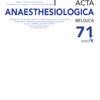A survey of anesthetists’ experience and perspectives of perioperative anaphylaxis at an Australian tertiary hospital
Anaphylaxis ; perioperative ; allergy ; adverse reaction ; anesthetic
Published online: Nov 25 2022
Abstract
Background : Anaphylaxis is a life-threatening emergency that requires prompt recognition and institution of life-saving therapy. Perioperative Anaphylaxis Management Guidelines have been developed by the Australian and New Zealand College of Anaesthetists and Australian and New Zealand Anaesthetic Allergy Group and anesthetic societies worldwide to facilitate diagnosis and management of this rare, but severe complication.
Objectives : To perform a cross-sectional survey of the anesthetists’ experience of perioperative anaphylaxis at a single centre and its effect on their practice.
Design : Survey questionnaire constructed in Survey Monkey® and sent via e-mail link to all anesthetists. This questionnaire included qualitative and quantitative questions.
Setting : Royal Brisbane and Women’s Hospital, a tertiary referral hospital in Queensland.
Methods : Anesthetic specialists and provisional fellows at The Royal Brisbane and Women’s Hospital were surveyed using an online platform regarding their experiences of managing anaphylaxis, referral for testing, formal incident reporting and knowledge of existing departmental protocol. We also asked if their experience of anaphylaxis modified their clinical practice.
Results : Forty-five out of 102 (44%) of the specialists and provisional fellows surveyed responded. Of these, 17 (38%) had been involved as primary anesthetist and 20 (44.5%) indirectly in at least one suspected case of perioperative anaphylaxis in the past 12-months. Most anesthetists were aware of the resources available in this crisis and appropriate referral for testing had occurred. There was poor local and national reporting of anaphylaxis as a critical incident.
Conclusion : A large percentage of the anesthetists surveyed had seen a case of perioperative anaphylaxis in the past year. Managing this life-threatening event has led to practice change for many anesthetists. There is a requirement for further education around incident reporting.
